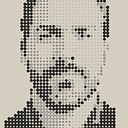The Work of Art in the Age of “Mechanical” Reproduction: Reflections in the Age of Artificial Intelligence
(Italian 🇮🇹 version here)
In his seminal essay “The Work of Art in the Age of Mechanical Reproduction,” Walter Benjamin deeply explored how the techniques of mechanical reproduction made possible by photography and cinema in the early 20th century radically transformed the status, aura, and value of artworks. Today, in the era of artificial intelligence, we find ourselves facing a new revolutionary turning point in the reproducibility of art, with even more disruptive consequences.
If in the transition from the uniqueness of the artisanal artefact to the technical serialization studied by Benjamin, the auratic “hic et nunc” (here and now) of the artwork was lost, today, with the advent of AI, this dematerialization of art reaches its culmination. Artificial intelligence enables not only the infinite reproduction of existing works but also the creation of completely new ones, devoid of an original and sacred uniqueness. Through sophisticated machine learning algorithms and deep neural networks, AI is capable of generating images, music, and texts that imitate and elaborate on various artistic styles and genres.
The Aura of Art in the Age of AI
According to Benjamin, mechanically reproducible art loses its “aura,” a term he used to indicate the uniqueness and authenticity of a work linked to its specific historical and material context. In the era of AI, we can question: what becomes of the aura of artworks? The creations produced by complex algorithms of automatic learning and deep learning, such as Generative Adversarial Networks (GANs), raise unprecedented questions about uniqueness and originality. If artwork is created by an algorithm, who is the true author? Is it the algorithm itself as an artificial agent, the programmer who wrote its code, or the starting datasets from which the machine learned? Can we still speak of an auratic aura when the work originates from a non-human intelligence?
If, for Benjamin, mechanically reproduced art lost its ritual authority, today it is the absence of the artist in the flesh and bones in the work generated by AI that completely dissolves that aura of uniqueness and authenticity. The artist no longer unambiguously shapes their creation but becomes a coordinator and trainer of intelligent machines that create independently.
The Function of Reproducibility in the Era of AI
Benjamin believed that mechanical reproducibility had transformed art from ritual into a political act capable of reaching the masses. Today, with the advent of AI, we witness a similar metamorphosis. Thanks to AI, architectural design is no longer the exclusive domain of a few professionals; intuitive and automated design tools potentially enable anyone to conceive and share their creations.
Digital reproducibility, combined with AI, greatly expands the field of creative possibilities in architecture, making design a democratic and participatory act. At the same time, AI allows for the generation of artworks and innovative projects that surpass human limits, questioning traditional notions of creativity and imagination.
Even the exhibition and aesthetic value of artworks, which Benjamin associated with the bourgeois institution of museums and galleries, are now redefined by the digital dematerialization of art and its potential global dissemination online. AI creations can be displayed in virtual galleries or on digital screens, reproduced infinitely, and accessible to a universal audience (ever heard of NFTs?).
AI and the Political Implications of Creation
For Benjamin, mechanical reproducibility was a tool of emancipation capable of freeing art from cultural elites. Nevertheless, the advent of AI brings forth new challenges and uncertainties. Who controls the algorithms that create art? What are the ethical implications of art generated by non-human intelligence? How can AI be manipulated for manipulation and disinformation?
These questions require thoughtful critical reflection. As Benjamin reminded us, technology is not neutral but deeply intertwined with the power structures of the society in which it develops.
In conclusion, if for Benjamin mechanical reproducibility inaugurated the politicized aesthetics of the avant-garde, today, with the proliferation of AI, we are moving towards a new “algorithmic aesthetics,” whose cultural and social consequences are yet to be fully understood. It is up to contemporary thinkers to develop updated analyses that reconsider the new meaning that an artwork holds in the era of artificial intelligence.
